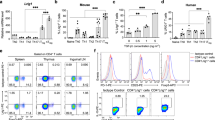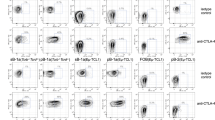Abstract
B cells regulate immune responses by producing antigen-specific antibodies1. However, specific B-cell subsets can also negatively regulate T-cell immune responses, and have been termed regulatory B cells2,3,4. Human and mouse regulatory B cells (B10 cells) with the ability to express the inhibitory cytokine interleukin-10 (IL-10) have been identified2,3,4,5. Although rare, B10 cells are potent negative regulators of antigen-specific inflammation and T-cell-dependent autoimmune diseases in mice5,6,7. How B10-cell IL-10 production and regulation of antigen-specific immune responses are controlled in vivo without inducing systemic immunosuppression is unknown. Using a mouse model for multiple sclerosis, here we show that B10-cell maturation into functional IL-10-secreting effector cells that inhibit in vivo autoimmune disease requires IL-21 and CD40-dependent cognate interactions with T cells. Moreover, the ex vivo provision of CD40 and IL-21 receptor signals can drive B10-cell development and expansion by four-million-fold, and generate B10 effector cells producing IL-10 that markedly inhibit disease symptoms when transferred into mice with established autoimmune disease. The ex vivo expansion and reinfusion of autologous B10 cells may provide a novel and effective in vivo treatment for severe autoimmune diseases that are resistant to current therapies.
This is a preview of subscription content, access via your institution
Access options
Subscribe to this journal
Receive 51 print issues and online access
$199.00 per year
only $3.90 per issue
Buy this article
- Purchase on Springer Link
- Instant access to full article PDF
Prices may be subject to local taxes which are calculated during checkout




Similar content being viewed by others
References
LeBien, T. W. & Tedder, T. F. B-lymphocytes: how they develop and function. Blood 112, 1570–1580 (2008)
DiLillo, D. J., Matsushita, T. & Tedder, T. F. B10 cells and regulatory B cells balance immune responses during inflammation, autoimmunity, and cancer. Ann. NY Acad. Sci. 1183, 38–57 (2010)
Fillatreau, S. Novel regulatory functions for Toll-like receptor-activated B cells during intracellular bacterial infection. Immunol. Rev. 240, 52–71 (2011)
Mauri, C. Regulation of immunity and autoimmunity by B cells. Curr. Opin. Immunol. 22, 761–767 (2010)
Iwata, Y. et al. Characterization of a rare IL-10-competent B cell subset in humans that parallels mouse regulatory B10 cells. Blood 117, 530–541 (2011)
Yanaba, K. et al. A regulatory B cell subset with a unique CD1dhiCD5+ phenotype controls T cell-dependent inflammatory responses. Immunity 28, 639–650 (2008)
Matsushita, T., Yanaba, K., Bouaziz, J.-D., Fujimoto, M. & Tedder, T. F. Regulatory B cells inhibit EAE initiation in mice while other B cells promote disease progression. J. Clin. Invest. 118, 3420–3430 (2008)
Ray, A., Basu, S., Williams, C. B., Salzman, N. H. & Dittel, B. N. A novel IL-10-independent regulatory role for B cells in suppressing autoimmunity by maintenance of regulatory T cells via GITR ligand. J. Immunol. 188, 3188–3198 (2012)
Yanaba, K., Bouaziz, J.-D., Matsushita, T., Tsubata, T. & Tedder, T. F. The development and function of regulatory B cells expressing IL-10 (B10 cells) requires antigen receptor diversity and TLR signals. J. Immunol. 182, 7459–7472 (2009)
Haas, K. M. et al. Protective and pathogenic roles for B cells during systemic autoimmunity in NZB/W F1 mice. J. Immunol. 184, 4789–4800 (2010)
Matsushita, T., Horikawa, M., Iwata, Y. & Tedder, T. F. Regulatory B cells (B10 cells) and regulatory T cells have independent roles in controlling EAE initiation and late-phase immunopathogenesis. J. Immunol. 185, 2240–2252 (2010)
Horikawa, M., Minard-Colin, V., Matsushita, T. & Tedder, T. F. Regulatory B cell production of IL-10 inhibits lymphoma depletion during CD20 immunotherapy in mice. J. Clin. Invest. 121, 4268–4280 (2011)
Maseda, D. et al. Regulatory B10 cells differentiate into antibody-secreting cells after transient IL-10 production in vivo. J. Immunol. 188, 1036–1048 (2012)
Spolski, R. & Leonard, W. J. IL-21 and T follicular helper cells. Int. Immunol. 22, 7–12 (2009)
Linterman, M. A. & Vinuesa, C. G. T follicular helper cells during immunity and tolerance. Prog. Mol. Biol. Transl. Sci. 92, 207–248 (2010)
Ettinger, R. et al. IL-21 induces differentiation of human naive and memory B cells into antibody-secreting plasma cells. J. Immunol. 175, 7867–7879 (2005)
Ozaki, K. et al. Regulation of B cell differentiation and plasma cell generation by IL-21, a novel inducer of Blimp-1 and Bcl-6. J. Immunol. 173, 5361–5371 (2004)
Ozaki, K. et al. A critical role for IL-21 in regulating immunoglobulin production. Science 298, 1630–1634 (2002)
Spolski, R., Kim, H. P., Zhu, W., Levy, D. E. & Leonard, W. J. IL-21 mediates suppressive effects via its induction of IL-10. J. Immunol. 182, 2859–2867 (2009)
Pot, C. et al. Cutting edge: IL-27 induces the transcription factor c-Maf, cytokine IL-21, and the costimulatory receptor ICOS that coordinately act together to promote differentiation of IL-10-producing Tr1 cells. J. Immunol. 183, 797–801 (2009)
Bettelli, E. et al. Myelin oligodendrocyte glycoprotein-specific T cell receptor transgenic mice develop spontaneous autoimmune optic neuritis. J. Exp. Med. 197, 1073–1081 (2003)
Bettelli, E. et al. Reciprocal developmental pathways for the generation of pathogenic effector TH17 and regulatory T cells. Nature 441, 235–238 (2006)
Chen, G. et al. Regulation of the IL-21 gene by the NF-κB transcription factor c-Rel. J. Immunol. 185, 2350–2359 (2010)
Poe, J. C. et al. Amplified B lymphocyte CD40 signaling drives regulatory B10 cell expansion in mice. PLoS ONE 6, e22464 (2011)
Nojima, T. et al. In-vitro derived germinal centre B cells differentially generate memory B or plasma cells in vivo. Nature Comm. 2, 465 (2011)
Goodnow, C. C. et al. Altered immunoglobulin expression and functional silencing of self-reactive B lymphocytes in transgenic mice. Nature 334, 676–682 (1988)
Coquet, J. M., Chakravarti, S., Smyth, M. J. & Godfrey, D. I. Cutting edge: IL-21 is not essential for Th17 differentiation or experimental autoimmune encephalomyelitis. J. Immunol. 180, 7097–7101 (2008)
Hoehlig, K. et al. Activation of CD4+ Foxp3+ regulatory T cells proceeds normally in the absence of B cells during EAE. Eur. J. Immunol. 42, 1164–1173 (2012)
Weber, M. S. et al. Type II monocytes modulate T cell-mediated central nervous system autoimmune disease. Nature Med. 13, 935–943 (2007)
Matsushita, T. & Tedder, T. F. Identifying regulatory B cells (B10 cells) that produce IL-10. Methods Mol. Biol. 677, 99–111 (2011)
Kühn, R., Lohler, J., Rennick, D., Rajewsky, K. & Muller, W. Interleukin-10-deficient mice develop chronic enterocolitis. Cell 75, 263–274 (1993)
Grusby, M. J. et al. Mice lacking major histocompatibility complex class I and class II molecules. Proc. Natl Acad. Sci. USA 90, 3913–3917 (1993)
Sato, S., Ono, N., Steeber, D. A., Pisetsky, D. S. & Tedder, T. F. CD19 regulates B lymphocyte signaling thresholds critical for the development of B-1 lineage cells and autoimmunity. J. Immunol. 157, 4371–4378 (1996)
Sato, S., Steeber, D. A., Jansen, P. J. & Tedder, T. F. CD19 expression levels regulate B lymphocyte development: human CD19 restores normal function in mice lacking endogenous CD19. J. Immunol. 158, 4662–4669 (1997)
Zhou, L.-J. et al. Tissue-specific expression of the human CD19 gene in transgenic mice inhibits antigen-independent B lymphocyte development. Mol. Cell. Biol. 14, 3884–3894 (1994)
Tedder, T. F., Wagner, N. & Engel, P. in Leukocyte Typing V: White Cell Differentiation Antigens Vol. 1 (eds Schlossman, S. F. et al.) 483–504 (Oxford Univ. Press, 1995)
Fillatreau, S., Sweenie, C. H., McGeachy, M. J., Gray, D. & Anderton, S. M. B cells regulate autoimmunity by provision of IL-10. Nature Immunol. 3, 944–950 (2002)
Acknowledgements
We thank D. Maseda, E. Weimer, J. Bryant, K. Candando and G. Venturi for help and comments. These studies were supported by grants from the National Institutes of Health (NIH; AI56363 and AI057157), the Lymphoma Research Foundation, and the Division of Intramural Research, National Heart, Lung, and Blood Institute, NIH.
Author information
Authors and Affiliations
Contributions
A.Y., T.Mi., D.J.D., T.Ma., M.H., J.C.P., W.J.L. and T.F.T. conceived and designed the studies. A.Y., T.Mi., D.J.D., T.Ma., M.H., E.I.K., R.S., J.C.P. and W.J.L. carried out or contributed essential reagents and materials for the experiments. All authors contributed to data analysis and manuscript preparation.
Corresponding author
Ethics declarations
Competing interests
T.F.T. is a consultant and shareholder for Angelica Therapeutics, Inc. R.S. and W.J.L. are inventors on patents and patent applications related to IL-21. The other authors have no financial conflicts of interest.
Supplementary information
Supplementary Figures
This file contains Supplementary Figures 1-2. (PDF 266 kb)
Rights and permissions
About this article
Cite this article
Yoshizaki, A., Miyagaki, T., DiLillo, D. et al. Regulatory B cells control T-cell autoimmunity through IL-21-dependent cognate interactions. Nature 491, 264–268 (2012). https://doi.org/10.1038/nature11501
Received:
Accepted:
Published:
Issue Date:
DOI: https://doi.org/10.1038/nature11501
This article is cited by
-
B cells in head and neck squamous cell carcinoma: current opinion and novel therapy
Cancer Cell International (2024)
-
The role of regulatory B cells in immune regulation and childhood allergic asthma
Molecular and Cellular Pediatrics (2024)
-
Advances in immune checkpoint-based immunotherapies for multiple sclerosis: rationale and practice
Cell Communication and Signaling (2023)
-
Inflammatory mediators drive neuroinflammation in autism spectrum disorder and cerebral palsy
Scientific Reports (2023)
-
CD19+CD24highCD27+ B cell and interleukin 35 as potential biomarkers of disease activity in systemic lupus erythematosus patients
Advances in Rheumatology (2022)
Comments
By submitting a comment you agree to abide by our Terms and Community Guidelines. If you find something abusive or that does not comply with our terms or guidelines please flag it as inappropriate.



